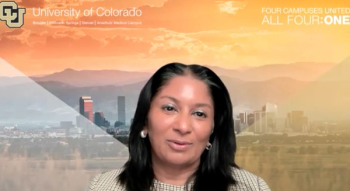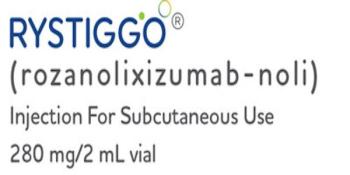
Interview: Real-World Data Show Daratumumab 1L Improves OS in Some Patients With MM
For patients with multiple myeloma (MM) who are not eligible for transplant, should novel treatments be used right away? Or should clinicians save the best potential therapies for relapses, which are inevitable with this disease?
For patients with multiple myeloma (MM) who are not eligible for transplant, should novel treatments be used right away? Or should clinicians save the best potential therapies for relapses, which are inevitable with this disease? As the number of available therapies has increased, so has debate on this topic. An abstract presented during the 63rd Annual American Society of Hematology Meeting offers an analysis in which investigators used deidentified electronic health record data from Flatiron Health to simulate sequences from 2 published clinical trials. One sequence was based on the MAIA trial, involving daratumumab (Darzalex), lenalidomide (Revlimid), and dexamethasone, and the other was based on the SWOG-S0777 trial, using bortezomib (Velcade), lenalidomide, and dexamethasone (VRd). Simulations aimed to evaluate the value of using daratumumab first, compared with saving it for later use. The findings showed that using daratumumab in the first-line setting improved median overall survival (OS) by 2.5 or 3.5 years, compared with delaying its use until the second-line setting, after the VRd combination or Rd, respectively.1
Evidence-Based Oncology™ discussed the findings with the abstract’s lead author, Rafael Fonseca, MD, who is a hematologist, chief innovation officer, and the Getz Family Professor of Cancer at Mayo Clinic in Arizona.
This interview has been edited slightly for conciseness and clarity.
EVIDENCE-BASED ONCOLOGY™ (EBO): Until now,what has been the rationale for waiting for second line to use daratumumab in these multiple myeloma patients?
FONSECA: Theregimen to be used for first-line treatment of myeloma patients is a critical decision that should consider a number of factors—predominantly, the efficacy of the regimen. We’re very fortunate that we have a growing list of options that can be used for first-line treatment, particularly for transplant-ineligible patients.
Historically, people have thought that it might make sense to think how we could spread out the various treatments that are available for patients—this so-called sequencing. This approach has been used in other cancers—for example, breast cancer. But as it turns out, for multiple myeloma, that may not make the most sense. We have learned through the careful analysis of real-world datasets that there is significant attrition by line of treatment for patients. This [is what] happens in the real world.
We published a study last year that found when you look at the attrition rates for the transplant-eligible patients, it’s about 30% per line of treatment; for transplant-ineligible patients, it’s about 50%.2 This means that if you save a drug for a future you think might exist later down the line, you may find yourself without that being an option for future treatment of patients. So, our thinking on this has changed. I know we’re talking about daratumumab, but this is agnostic to any medicines. The concept is, use your best treatments up front and don’t save them for later, because you don’t know whether you will have that later opportunity to use them.
EBO: Could you discuss your approach to deciding whether to use daratumumab in a first-line combination or to wait to use it in a second-line treatment?
FONSECA: As new papers have been published and presentations have been made with the results of these clinical trials, we are asking the question: What is the best approach for treating a patient who is transplant ineligible? One thing we asked ourselves and presented at the American Society of Hematology [ASH] meeting was: Does it make sense to start with a treatment that contains daratumumab, such as was presented by the MAIA regimen,3 or does it make sense with start with something else—something like VRd, which has been published by the SWOG clinical trial S07774—and then use daratumumab down the line?
We did some modeling to try to answer this. The [modeling] projects the survival statistics that we have from the clinical trials, but also [statistics] from the real world, for what would be the rescue strategies. Very importantly, we introduced a factor of attrition, and even using a very conservative estimate for attrition—we use 27%—we find that [starting with] daratumumab, lenalidomide, and dexamethasone, vs starting with VRd, [results in] a projected OS difference by this model of approximately 2.5 years, [in favor of the daratumumab combination].
EBO: Was the survival benefit from daratumumab being used in the first line particularly pronounced for any subgroups?
FONSECA: In our particular study, we did not do subgroup analysis to identify which patients may benefit more from a given approach. It should be noted, however, that a common perception has been that if someone has high-risk disease, one should use proteasome inhibitors. That concept has been present for a while, but I think it deserves some scrutiny, particularly given the currently available data.
Number 1, the presence of high-risk markers is seen only in about 10% of transplant-ineligible patients. High-risk disease is far more common in younger patients diagnosed with multiple myeloma. And number 2, most literature that [has] come out regarding the use of proteasome inhibitors for high-risk disease comes from a time when we were comparing proteasome inhibitors vs immunomodulatory drugs [IMiDs]. We found through multiple studies—data from the various European group studies—that proteasome inhibitors could overcome some of the negative implications of things like deletion 17 or t(4;14).
But something interesting has happened. We have seen that other drugs appear to confer similar benefit. A meta-analysis by Smith Giri, MD, MHS, was published last year in JAMA Oncology, for daratumumab.5 Data are emerging for selinexor. And we have seen some data, as well, for some of the other immune-mediated therapies that are being presented for myeloma.
So, I asked myself the question: Is it really that proteasome inhibitors were better for high-risk disease? This is possible. Or, is it that we just were seeing that high-risk disease patients were not deriving benefit from treatment with IMiDs alone? I think [the latter] is the most likely scenario: first, because of what I [mentioned about] new drugs being effective in high-risk disease, and second, because it didn’t make sense that the one class of drugs would be effective for different biology—that is, P53 and t(4;14). Maybe what we’re seeing is just that better drugs are more important, even for the high-risk group.
So again, we didn’t do the subgroup analysis, but I think this would be an important part of the conversation as to why one might choose one regimen over another. I would suggest that it probably can be for this particular patient population, to some degree even agnostic of risk classification.
EBO: Based on the data you have seen, do some groups have more ability to gain access to daratumumab in the first-line setting than others?
FONSECA: I think a growing percentage of patients is being treated with daratumumab combinations. We obviously will see that in transplant-eligible patients as well, [because] studies like GRIFFIN, soon PERSEUS, CASSIOPEIA, etc, are showing the great benefit of the addition of daratumumab to the induction regimen for transplant-eligible patients. I think a lot of this relates to the familiarity that people might have with the regimen.
I think we see that for many physicians in community practices, myeloma may represent only a small fraction of their practice; they may not be as familiar with some of the regimens, like the MAIA study. It’s important to recognize that the dissemination of this information will be critical so there’s greater acceptance and familiarity, because efficacy and safety really stand on their own.
Physicians have been historically very comfortable with treatments like VRd for frontline treatment for patients with multiple myeloma. But if you look at the clinical trials, like this SWOG study, you will see that the OS benefit that was reported was primarily for patients aged less than 65 years. The OS benefit was not present or detectable in patients who were aged more than 65 years. The curves separate, but just by a little, and the P value is not of significance. So, we don‘t see the OS benefit in the elderly. In contrast, with recently reported data regarding OS as it relates to the MAIA regimen, at 5 years it was close to 66%; this was really remarkable and much higher than ever has been published before for this patient population.
EBO: Does payer coverage play a role in the ability of patients with multiple myeloma to gain access to this daratumumab combination?
FONSECA: Fortunately, we have greater ease now in the prescription of daratumumab up front, for 2 reasons. First, we have FDA approval for the up-front regimen, as is true for the MAIA regimen, so I don’t think that should be something that holds back people from thinking about being able to use daratumumab up front. Second, we also have support for this regimen by multiple pathways or treatment guidelines. We certainly have that through the National Comprehensive Cancer Network guidelines, as well as our own institutional guidelines from mSMART.6 I think it’s pretty unanimous right now that this should be an option that is considered for patients. So I think more than regulatory [issues], it’s more familiarity and the practice of a center.
But if you’re a center that treats a lot of myeloma patients, I would suggest that we need to pay a lot of attention to peripheral neuropathy. To me, that’s the biggest factor. One of the greatest detriments to the quality of life of myeloma patients right now is just persistent peripheral neuropathy, which still occurs, even though it’s much better when we use bortezomib in a subcutaneous weekly fashion. In some cases, it can be a bit idiosyncratic and lead to very profound peripheral neuropathy. It’s one of the lingering adverse effects that I’ve seen in a significant number of patients in my treatment population.
For that reason—their ability to be able to have such effective and profound responses—durative treatment [that is] without the risk of peripheral neuropathy really makes this a very attractive combination in the selection of frontline therapy.
EBO: What is necessary to improve the level of education and awareness surrounding daratumumab?
FONSECA: It’s very important to disseminate this information and provide coverage for the meetings. I think it’s important to showcase this at the continuing medical education events and, in general, just for physicians to be aware. If you look at market utilization, it’s a smaller fraction than what I wish I would see actually reflected in the numbers. In my mind, this is not necessarily because it’s controversial, but because having access to that information [has been limited]. If people were to see those results, I think it would be pretty self-evident that this would be an excellent standard of care for that patient population.
EBO: Have dissemination and education been more challenging because of the pandemic?
FONSECA: I think it’s actually been better. Now, I tend to be pathologically optimistic, so you can take this with a grain of salt, but I think the ability to bring together groups of people has been greatly enhanced because of Zoom. It’s because the economics—not only the way we think classically of the monetary value, but the economics of time that have occurred with this, where you can join an educational session for an hour without having to travel and then be able to enjoy dinner with your family—are just incredible.
I think we’d rather do some things in person. I certainly would rather be at the ASH meeting, at the American Society of Clinical Oncology meeting, but on the other hand, it’s not unusual for me to be doing a presentation to international colleagues at least once per week where we talk about myeloma, where we talk about updates on the treatment, etc….
I think the type of research that we’re presenting at the ASH meeting is something we’ll see more and more, which is using these large datasets. While for some questions it doesn’t have the purity or the parameters that would allow us to conclusively recheck conclusions, such as you can do with a phase 3 trial, just a wealth of information is out there that we can learn from. I think, ultimately, that it’s all for the betterment of our patients.
References
1. Fonseca R, Facon T, Hashim M, et al. First-line use of daratumumab, lenalidomide, and dexamethasone confers survival benefit compared with second-line use of daratumumab-based regimens in transplant-ineligible patients with multiple myeloma: analysis of different clinical scenarios. Blood. 2021;138(suppl 1):118.
2. Fonseca R, Usmani SZ, Mehra M, et al. Frontline treatment patterns and attrition rates by subsequent lines of therapy in patients with newly diagnosed multiple myeloma. BMC Cancer. 2020;20(1):1087. doi:10.1186/s12885-020-07503-y
3. Facon T, Kumar SK, Plesner T, et al. Daratumumab, lenalidomide, and dexamethasone versus lenalidomide and dexamethasone alone in newly diagnosed multiple myeloma (MAIA): overall survival results from a randomised, open-label, phase 3 trial. Lancet Oncol. 2021;22(11):1582-1596. doi:10.1016/S1470-2045(21)00466-6
4. Durie BGM, Hoering A, Sexton R, et al. Longer term follow-up of the randomized phase 3 trial SWOG S0777: bortezomib, lenalidomide and dexamethasone vs. lenalidomide and dexamethasone in patients (pts) with previously untreated multiple myeloma without an intent for immediate autologous stem cell transplant (ASCT). Blood Cancer J. 2020;10(5):53. doi:10.1038/s41408-020-0311-8
5. Giri S, Grimshaw A, Bal S, et al. Evaluation of daratumumab for the treatment of multiple myeloma in patients with high-risk cytogenic factors: a systematic review and meta-analysis. JAMA Oncol. 2020;6(11):1759-1765. doi:10.1001/jamaoncol.2020.4338
6. Ailawadhi S, Ansell S, Bergsagel L, et al. Treatment guidelines: multiple myeloma. mSMART stratification for myeloma and risk-adapted therapy. Accessed December 5, 2021.
Newsletter
Stay ahead of policy, cost, and value—subscribe to AJMC for expert insights at the intersection of clinical care and health economics.














































